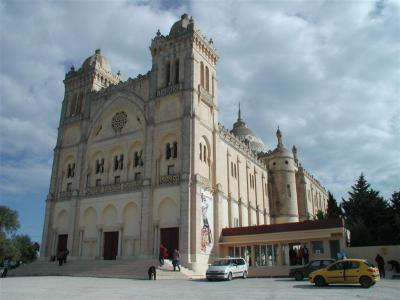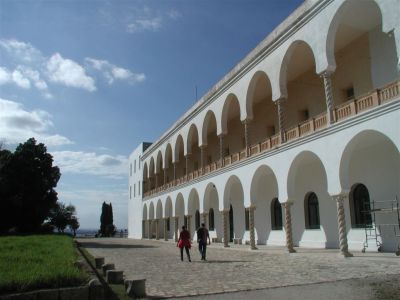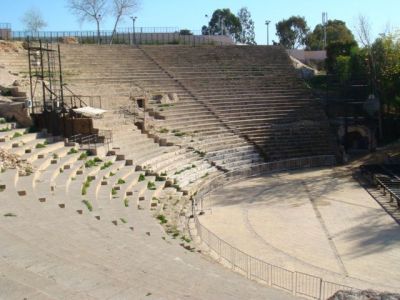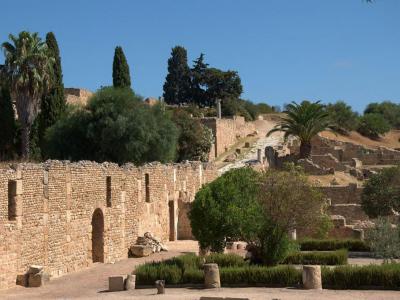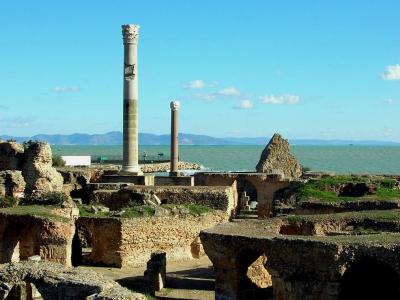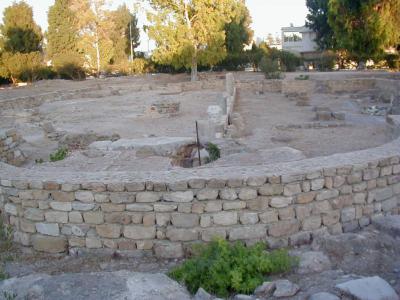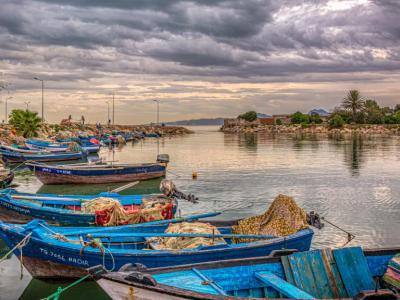Carthage Walking Tour (Self Guided), Tunis
Carthage is a modern, upscale seaside suburb of Tunis and a unique place of archaeological and cultural value, situated at the site of an ancient capital of the Carthaginian (Punic) civilization, which fell to Rome in the 2nd century BC.
The settlement was founded by the Phoenicians in the first millennium BC and, after being destroyed by the Romans in the course of three Punic Wars, emerged as Roman Carthage, the major city of Africa Proconsularis (Roman province on the North African coast), eventually becoming one of the most important trading hubs of the Ancient Mediterranean and one of the most affluent cities of the classical world.
Following the conquest by the Byzantine Empire, Carthage was then occupied and used as a fort by the Muslims, from 698 until the 13th century, when the Crusaders took it during the Eighth Crusade. For another 900 years, until the early 20th century, Carthage had been little more than an agricultural village, though. It started to develop into a coastal suburb of Tunis and was finally incorporated as a municipality in 1919.
The archaeological site of Carthage was first surveyed in 1830, upon which The Carthage National Museum was established, in 1875. The open-air Carthage Paleo-Christian Museum contains the exhibits excavated here, under the auspices of UNESCO, from 1975 to 1984.
Declared a UNESCO World Heritage Site, the ancient ruins has made Carthage a major tourist attraction. Here, alongside centuries-old monuments, such as the Baths of Antoninus – the largest set of Roman thermae built on the African continent, the Carthage Amphitheatre, and the Punic Port – reminiscent of what ancient Carthage would have looked like, back in the day, you will find more modern landmarks, such as The Acropolium of Carthage, a Roman Catholic cathedral constructed in 1890.
To explore more closely these and other prominent locations of Carthage, take our self-guided walking tour and discover the historic part of Tunisia's capital in all its splendour!
The settlement was founded by the Phoenicians in the first millennium BC and, after being destroyed by the Romans in the course of three Punic Wars, emerged as Roman Carthage, the major city of Africa Proconsularis (Roman province on the North African coast), eventually becoming one of the most important trading hubs of the Ancient Mediterranean and one of the most affluent cities of the classical world.
Following the conquest by the Byzantine Empire, Carthage was then occupied and used as a fort by the Muslims, from 698 until the 13th century, when the Crusaders took it during the Eighth Crusade. For another 900 years, until the early 20th century, Carthage had been little more than an agricultural village, though. It started to develop into a coastal suburb of Tunis and was finally incorporated as a municipality in 1919.
The archaeological site of Carthage was first surveyed in 1830, upon which The Carthage National Museum was established, in 1875. The open-air Carthage Paleo-Christian Museum contains the exhibits excavated here, under the auspices of UNESCO, from 1975 to 1984.
Declared a UNESCO World Heritage Site, the ancient ruins has made Carthage a major tourist attraction. Here, alongside centuries-old monuments, such as the Baths of Antoninus – the largest set of Roman thermae built on the African continent, the Carthage Amphitheatre, and the Punic Port – reminiscent of what ancient Carthage would have looked like, back in the day, you will find more modern landmarks, such as The Acropolium of Carthage, a Roman Catholic cathedral constructed in 1890.
To explore more closely these and other prominent locations of Carthage, take our self-guided walking tour and discover the historic part of Tunisia's capital in all its splendour!
How it works: Download the app "GPSmyCity: Walks in 1K+ Cities" from Apple App Store or Google Play Store to your mobile phone or tablet. The app turns your mobile device into a personal tour guide and its built-in GPS navigation functions guide you from one tour stop to next. The app works offline, so no data plan is needed when traveling abroad.
Carthage Walking Tour Map
Guide Name: Carthage Walking Tour
Guide Location: Tunisia » Tunis (See other walking tours in Tunis)
Guide Type: Self-guided Walking Tour (Sightseeing)
# of Attractions: 7
Tour Duration: 2 Hour(s)
Travel Distance: 4.0 Km or 2.5 Miles
Author: leticia
Sight(s) Featured in This Guide:
Guide Location: Tunisia » Tunis (See other walking tours in Tunis)
Guide Type: Self-guided Walking Tour (Sightseeing)
# of Attractions: 7
Tour Duration: 2 Hour(s)
Travel Distance: 4.0 Km or 2.5 Miles
Author: leticia
Sight(s) Featured in This Guide:
- Acropolium of Carthage
- Musée National de Carthage (Carthage National Museum)
- Carthage Amphitheatre
- Parc des Villas Romaines (Park of the Roman Villas)
- Thermes d'Antonin (Baths of Antoninus)
- Carthage Paleo-Christian Museum
- Punic Port
1) Acropolium of Carthage
The Acropolium of Carthage is a Roman Catholic church in Carthage. The cathedral rests on Byrsa Hill among the ruins of Carthage. It was constructed in 1890 when it was known as Cathedrale Saint-Louis de Carthage, or Saint Louis Cathedral.
The cathedral was built on the ruins of a temple dedicated to Eshmun, the Punic god of healing. It was dedicated to Saint Louis due to that being the spot where he was killed during the Eighth Crusade.
The building was designed by French architect Abbot Pougnet. He used Byzantine, Gothic and Moorish architectural styles to create a unique place of worship. It has two square towers, two cupolas and a series of spires. The building is laid out in the shape of a Latin cross.
The Acropolium of Carthage has not been used as a place of worship since 1993. It is now a venue for public events and concerts. It is also a popular tourist attraction. Those who glimpse inside the Acropolium will find numerous artifacts and mosaics that date to the late 19th century.
Tip:
You can take the stairs to get to the 2nd level, but there's no access to the roof/bell towers.
The cathedral was built on the ruins of a temple dedicated to Eshmun, the Punic god of healing. It was dedicated to Saint Louis due to that being the spot where he was killed during the Eighth Crusade.
The building was designed by French architect Abbot Pougnet. He used Byzantine, Gothic and Moorish architectural styles to create a unique place of worship. It has two square towers, two cupolas and a series of spires. The building is laid out in the shape of a Latin cross.
The Acropolium of Carthage has not been used as a place of worship since 1993. It is now a venue for public events and concerts. It is also a popular tourist attraction. Those who glimpse inside the Acropolium will find numerous artifacts and mosaics that date to the late 19th century.
Tip:
You can take the stairs to get to the 2nd level, but there's no access to the roof/bell towers.
2) Musée National de Carthage (Carthage National Museum)
Located atop Byrsa Hill, the Carthage National Museum is one of two primary archaeological museums in the region, the other being the Bardo National Museum. Its origins date back to 1875 when it was founded by Cardinal Charles Martial Lavigerie on the site of a monastery. Originally called the Museum Lavigerie, it was renamed the Carthage National Museum in 1956.
The museum officially opened as a national museum in 1963 and is the result of excavations carried out by European archaeologists, including Alfred Louis Delattre. Notably, excavations in 1975 uncovered a Late Roman house with fragments of Roman mosaics, as well as a large church dating back to the 5th century AD. Plans to create a site museum were initiated in 1983, and it was finally opened a year later.
Visitors to the Carthage National Museum can appreciate the grandeur of Carthage during the Punic and Roman eras. The museum boasts a collection of limestone and marble carvings depicting animals, plants, and even human sculptures. Among its best pieces is a marble sarcophagus of a priest and priestess from the 3rd century BC, discovered in the necropolis of Carthage. The museum also showcases a notable collection of masks and jewelry in cast glass, Roman mosaics, including the famous "Lady of Carthage," and a vast array of Roman amphorae. Additionally, the exhibits feature numerous items from the Byzantine period, as well as ivory objects.
The museum is located near the Cathedral of Saint-Louis, making it a convenient stop for those interested in exploring Carthage's rich history.
Tip:
A ticket bought here allows access to all historic sites in the Carthage area, such as the Roman Theater, the baths, villas, etc. Consider hiring a guide to bring you around and explain the history of Tunisia and the story behind the ancient ruins. Early or late evening is the best time to visit, as there are fewer tour buses then.
The museum officially opened as a national museum in 1963 and is the result of excavations carried out by European archaeologists, including Alfred Louis Delattre. Notably, excavations in 1975 uncovered a Late Roman house with fragments of Roman mosaics, as well as a large church dating back to the 5th century AD. Plans to create a site museum were initiated in 1983, and it was finally opened a year later.
Visitors to the Carthage National Museum can appreciate the grandeur of Carthage during the Punic and Roman eras. The museum boasts a collection of limestone and marble carvings depicting animals, plants, and even human sculptures. Among its best pieces is a marble sarcophagus of a priest and priestess from the 3rd century BC, discovered in the necropolis of Carthage. The museum also showcases a notable collection of masks and jewelry in cast glass, Roman mosaics, including the famous "Lady of Carthage," and a vast array of Roman amphorae. Additionally, the exhibits feature numerous items from the Byzantine period, as well as ivory objects.
The museum is located near the Cathedral of Saint-Louis, making it a convenient stop for those interested in exploring Carthage's rich history.
Tip:
A ticket bought here allows access to all historic sites in the Carthage area, such as the Roman Theater, the baths, villas, etc. Consider hiring a guide to bring you around and explain the history of Tunisia and the story behind the ancient ruins. Early or late evening is the best time to visit, as there are fewer tour buses then.
3) Carthage Amphitheatre
The Carthage Amphitheater is an ancient Roman venue built in Carthage during the late 1st or early 2nd century AD. It is one of the three amphitheaters in Africa constructed on flat land, with the other two being El Jem and Thapsus. An inscription from 133-139 AD verifies that the amphitheater was already in use at that time and was further expanded during the 3rd century. It had a seating capacity of 30,000.
During the Middle Ages, the building impressed many visitors, including the Arab Andalusian historian and geographer, Al-Bakri, who described it as "the most wonderful in Carthage." The amphitheater was designed as a circle of arches supported by columns with different symbols representing the winds and animals, and various figures carved in relief, according to Al-Bakri and Al Idrissi, a Muslim geographer.
Unfortunately, the site was pillaged by looters, leaving only the arena surviving into the 20th century. Nevertheless, the wall has since been restored. A cross was erected in the center in 1887 to honor the martyrdom of two Catholic female saints, Perpetua and Felicity. Today, the amphitheater is still used for summer festivals.
During the Middle Ages, the building impressed many visitors, including the Arab Andalusian historian and geographer, Al-Bakri, who described it as "the most wonderful in Carthage." The amphitheater was designed as a circle of arches supported by columns with different symbols representing the winds and animals, and various figures carved in relief, according to Al-Bakri and Al Idrissi, a Muslim geographer.
Unfortunately, the site was pillaged by looters, leaving only the arena surviving into the 20th century. Nevertheless, the wall has since been restored. A cross was erected in the center in 1887 to honor the martyrdom of two Catholic female saints, Perpetua and Felicity. Today, the amphitheater is still used for summer festivals.
4) Parc des Villas Romaines (Park of the Roman Villas)
The Park of the Roman Villas sits on Odeon Hill, northeast of the Carthage archaeological site. The park is open to tourists who wish to see a well-preserved Roman villa, mosaics and the aviary.
The only villa that remains in good condition is the Villa of the Aviary. Significant restoration took place in the 1960s that focused on this villa. It has pink, marble columns, a square courtyard and a namesake mosaic of birds resting in foliage. It sits among a garden and an arboretum.
This villa has a terrace that opens onto the street. It also has an atrium, ceremonial apartments, a gallery and a foyer. There were also private apartments, baths and shops.
Primarily built in the 2nd century, most of the villas in this area are in disrepair, which stands in stark contrast to the highly restored Villa of the Aviary. In addition to villas, the site is also home to an amphitheater that was excavated in 1999.
The only villa that remains in good condition is the Villa of the Aviary. Significant restoration took place in the 1960s that focused on this villa. It has pink, marble columns, a square courtyard and a namesake mosaic of birds resting in foliage. It sits among a garden and an arboretum.
This villa has a terrace that opens onto the street. It also has an atrium, ceremonial apartments, a gallery and a foyer. There were also private apartments, baths and shops.
Primarily built in the 2nd century, most of the villas in this area are in disrepair, which stands in stark contrast to the highly restored Villa of the Aviary. In addition to villas, the site is also home to an amphitheater that was excavated in 1999.
5) Thermes d'Antonin (Baths of Antoninus)
The Baths of Antoninus, also called the Baths of Carthage, are the biggest Roman thermae constructed in Africa and one of the three largest in the Roman Empire. They were built during the reign of Emperor Antoninus Pius between 145 and 162 AD and are the only remaining Thermae of Carthage from the Roman era.
The site suffered from centuries of pillaging, serving as a stone quarry for Tunis and other cities in the northern Mediterranean, leading to the survival of only a part of the basement and some remnants of the ground floor.
The complex was discovered in the early 19th century and was recognized as a historical monument in 1901. Excavations since the end of World War Two led to the creation of an archaeological park, and the magnificent ruins of the Baths basement were first excavated in 1944.
In 1979, following a UNESCO international campaign, the Baths of Antoninus were listed as a World Heritage site and turned into the national park of Carthage and Sidi Bou Saïd.
Why You Should Visit:
It is one of the most important landmarks of Tunisia. The magnificent ruins, extending for over 300+ meters, provide an idea of the magnificence of this place in its heyday when the missing vaults rose to a height of more than 29 meters, approximately an eight-story building.
Tip:
If you have some knowledge of Carthage, then visiting independently would be fine; but if you don't, consider getting a tour as there isn't much information around the ruins.
The site suffered from centuries of pillaging, serving as a stone quarry for Tunis and other cities in the northern Mediterranean, leading to the survival of only a part of the basement and some remnants of the ground floor.
The complex was discovered in the early 19th century and was recognized as a historical monument in 1901. Excavations since the end of World War Two led to the creation of an archaeological park, and the magnificent ruins of the Baths basement were first excavated in 1944.
In 1979, following a UNESCO international campaign, the Baths of Antoninus were listed as a World Heritage site and turned into the national park of Carthage and Sidi Bou Saïd.
Why You Should Visit:
It is one of the most important landmarks of Tunisia. The magnificent ruins, extending for over 300+ meters, provide an idea of the magnificence of this place in its heyday when the missing vaults rose to a height of more than 29 meters, approximately an eight-story building.
Tip:
If you have some knowledge of Carthage, then visiting independently would be fine; but if you don't, consider getting a tour as there isn't much information around the ruins.
6) Carthage Paleo-Christian Museum
Carthage, a former Phoenician colony, developed into a dominant Punic Empire in the first millennium BC, controlling large areas of the Southwest Mediterranean. However, the city was destroyed by the Roman Republic in 146 BC and later rebuilt as Roman Carthage, becoming a major city in the Roman Empire's African province. Throughout the Muslim era, Carthage remained occupied, serving as a fort until the Crusaders brutally massacred its inhabitants during the Eighth Crusade.
Since the 19th century, various individuals and organizations have conducted surveys and excavations on the Carthage archaeological site. The Carthage National Museum was established in 1875, and UNESCO-led excavations from 1975 to 1984 led to the creation of the open-air Carthage Paleo-Christian Museum. The ruins of Carthage have been declared a UNESCO World Heritage Site, built over the former Carthaginian basilica. French archaeologists discovered evidence of child sacrifice in the 1920s, but scholars still debate its prevalence in ancient Carthage.
The Carthage Paleo-Christian Museum is an essential destination for anyone interested in the history and archaeology of ancient Carthage. Visitors can explore the remains of early Christian structures and examine an array of fascinating artifacts that provide insight into the religious practices and daily life of early Christians in Carthage.
Since the 19th century, various individuals and organizations have conducted surveys and excavations on the Carthage archaeological site. The Carthage National Museum was established in 1875, and UNESCO-led excavations from 1975 to 1984 led to the creation of the open-air Carthage Paleo-Christian Museum. The ruins of Carthage have been declared a UNESCO World Heritage Site, built over the former Carthaginian basilica. French archaeologists discovered evidence of child sacrifice in the 1920s, but scholars still debate its prevalence in ancient Carthage.
The Carthage Paleo-Christian Museum is an essential destination for anyone interested in the history and archaeology of ancient Carthage. Visitors can explore the remains of early Christian structures and examine an array of fascinating artifacts that provide insight into the religious practices and daily life of early Christians in Carthage.
7) Punic Port
The Carthage Punic Port and Museum recalls what the ports of ancient Carthage would have looked like before the fall of the city. The historic landmark shows the ruins of the port, which was destroyed by Romans in 146 BC.
The port was filled in after Carthage fell. In the 2nd century AD, Romans began using the area again by porting their merchant fleet in the area. They also built two temples on the site. After four centuries, it was entirely unused and eventually fell into the ruins that exist today.
A small museum rests in the area. It has models of what the port might have looked like when Carthage was in its prime. While the museum doesn't have a wide array of exhibits, it is worth seeing the models that were carefully put together.
Along with the ruins, visitors should go to the Punic Port to catch a stunning view of the Gulf of Tunis and the inlet that surrounds the port.
The port was filled in after Carthage fell. In the 2nd century AD, Romans began using the area again by porting their merchant fleet in the area. They also built two temples on the site. After four centuries, it was entirely unused and eventually fell into the ruins that exist today.
A small museum rests in the area. It has models of what the port might have looked like when Carthage was in its prime. While the museum doesn't have a wide array of exhibits, it is worth seeing the models that were carefully put together.
Along with the ruins, visitors should go to the Punic Port to catch a stunning view of the Gulf of Tunis and the inlet that surrounds the port.
Walking Tours in Tunis, Tunisia
Create Your Own Walk in Tunis
Creating your own self-guided walk in Tunis is easy and fun. Choose the city attractions that you want to see and a walk route map will be created just for you. You can even set your hotel as the start point of the walk.
Tunis Introduction Walking Tour
Tunis is the capital of Tunisia and one of the largest cities in the Arab world. Tunis was a Berber settlement founded on and around the ancient city of Carthage. The settlement of Tunis dates as far back as the 4th century BCE. It became the capital city in 1159.
The city was controlled by numerous empires over the years, which has lent to its interesting art and architecture. With influences... view more
Tour Duration: 1 Hour(s)
Travel Distance: 1.8 Km or 1.1 Miles
The city was controlled by numerous empires over the years, which has lent to its interesting art and architecture. With influences... view more
Tour Duration: 1 Hour(s)
Travel Distance: 1.8 Km or 1.1 Miles
Useful Travel Guides for Planning Your Trip
Tunisian Sweets and Pastries
No Tunisian meal is complete without a lavish dessert at the end. And Tunisians do take their sweets seriously, be it fresh seasonal fruits, cakes, fried almond pastries, ice cream, doughnuts or whatever else. Some of these delights have come from Turkey, brought by soldiers of the Ottoman army;...
Tunis Souvenirs: 15 Authentic Tunisian Products for Avid Traveler
A historic crossroads of many civilizations and influences, - Berber, Spanish, French, - Tunisia is a treasure trove of mementos waiting for a knowledgeable traveler to be picked up. The Medina market of Tunis (the capital city) is one of the best places to shop for local handcrafts. To help...
The Most Popular Cities
/ view all



